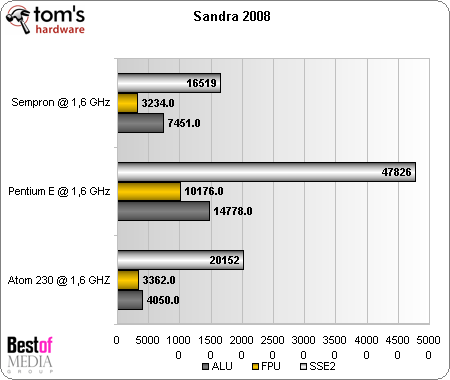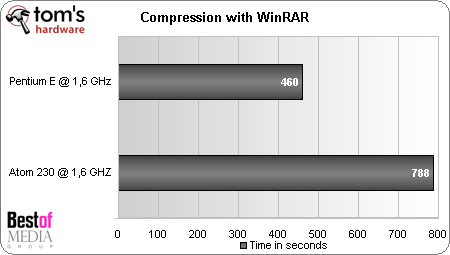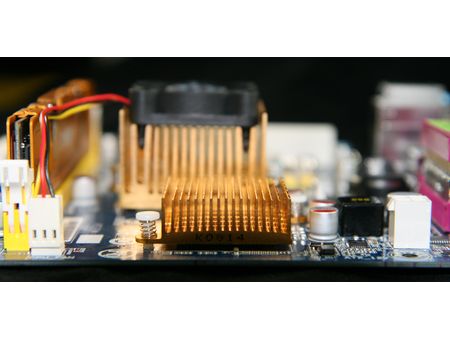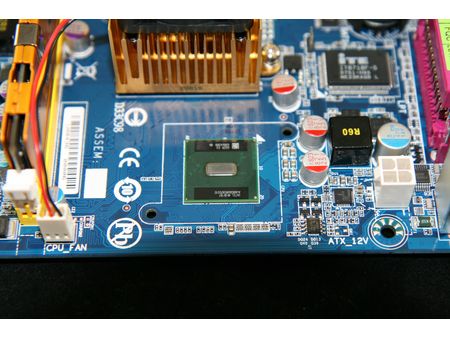Intel Atom CPU Review
Atom Against Pentium E and Sempron
For our tests, we used a Mini-ITX motherboard made by Gigabyte, equipped with an Atom 230/i945GC. The board has a single DIMM (DDR2) slot and a PCI port – which rules out using any modern graphics cards. Amusingly, the chipset (which, remember, consumes 22 W) is actively cooled, whereas the processor makes do with a simple aluminum heat sink.
Shootout
Since this motherboard is intended for entry-level machines, we tried to compare two current entry-level solutions – a Pentium E2160 (1.8 GHz factory), an entry-level dual-core processor based on the Core architecture, and a Sempron 3400+ (Socket 754 in this case). The two processors were set to the same clock frequency as the Atom (1.6 GHz) for the tests. The motherboard used for the Pentium E was a GA-GM945-S2. It has the advantage of using the same chipset (or almost) as the Atom motherboard – an i945G. The motherboard used with the Sempron is Nforce4-based.
The three boards were tested with the same system – Windows XP Service Pack 2 with all the drivers up to date. We used DDR2-667 memory (1 GB) on the Intel platforms and a 1 GB DDR-400 DIMM on the Sempron. Finally, our test hard disk was a 74 GB Western Digital Raptor.
The Tests
We decided to compare the three platforms at an identical frequency, with a few practical tests and a few synthetic ones.

On Cinebench R10, the Sempron placed between the Atom and the Pentium E, though the Atom-with-HyperThreading combo proved effective (1.53 times faster with HyperThreading). Notice that the increase with the Pentium E, which actually has two cores, is not that much greater: 1.86 times faster.

With Sandra, which is a synthetic test, the difference among the three processors was impressive. The Pentium E really was faster. Note that the difference between the Atom and the Sempron may seem slight, but the tests are multithreaded and the Sempron has only one core, whereas the Pentium E has two and the Atom uses HyperThreading, which can produce significant gains.

In the 3DMark 06 and PCMark 06 CPU tests, the Pentium E had a comfortable lead, and the Sempron always placed between the Atom and the Pentium E.
Get Tom's Hardware's best news and in-depth reviews, straight to your inbox.

In this test – a favorite with overclockers, but fundamentally not really conclusive (the code is dated and not very optimized) –, the Atom was a lot slower than its competitors.

Finally, we ran a test that consists of compressing approximately one GB of files with WinRAR. Since the Sempron uses a different memory subsystem (DDR) and a real graphics card, it doesn’t show up on this test – the comparison would have been thrown off. In practice, the difference between the two platforms was less than in the synthetic tests, but the Pentium E was still approximately twice as fast.
Current page: Atom Against Pentium E and Sempron
Prev Page Power Management: Tests and Theory Next Page Atom against C7-M and Celeron-
joefriday Celerons have significantly lower frequencies than Atom? umm...no. Only the ULV celeron M has a lower freqency. Modern notebooks start with Celerons at least 1.6GHz, more likely 1.86GHz, and are built on the much more modern Merom architecture, which have at least a 10% IPC advantage over the old Dothan architecture. No, atom is nowhere NEAR a modern Celeron in performance. Nice try though.Reply -
joefriday Also, Why not have a Celeron 420 by now? Are you telling me that THG, with all its money, can't budget in a $30 CPU for comparative testing?Reply -
joefriday After reviewing the article, I can say I'm thoroughly unimpressed with the Atom platform (at least the current desktop derivative). If anyone can remember, THG did a $300 PC build using now ancient Celeron Ds and AMD Semprons. One thing that I find amazing, is that those old rigs both use LESS power than this Atom desktop rig.Reply
http://www.tomshardware.com/reviews/the-300-pc,1546-10.html
-
randomizer Don't you people understand that Atom is not a desktop processor? You can't compare its performance to a desktop processor fairly because that's not what it is designed for.Reply -
joefriday This Atom CPU is on a desktop board. That means it's fair game, especially when the processors being compared are also comparable in price.Reply -
randomizer It's on a desktop board, woopdedoo. If you could get your mobile phone processor to run on a desktop board would you compare it to an E2160?Reply -
joefriday Who cares what the Atom CPU is SUPPOSED to be. It is right now, in this review, on a desktop-oriented package, built to compete with low power consumption desktop computers. It fails miserably in that regard, as it is neither low power consumption, nor competitive. In your ridiculous example, if I had a mobile phone processor on a desktop board, and it ended up consuming more power than an E2160/motherboard combo that costs the same amount of money, all the while performing much worse than the e2160, I would call the mobile phone cpu on a desktop motherboard either A FAILURE or AMD. Take your pick.Reply -
apaige So, for the Intel Atom, you do use an updated version of Sandra, but not for the Phenom. You compare it to the VIA C7, a 3 year-old CPU, but not the VIA Nano, which will be available in the same timeframe as the Atom. You don't provide graphics for power consumption, despite the Atom being designed for low power consumption; surprise, the old C7-M system draws less power.Reply
Biased much? -
Not sure that Nano's are really available yet, still a newer mini-itx based C7 (say EPIA-M700) would have been better, since you would be looking at even less power than the one used and the VX800 will end up used with the Nano. The D201DLY would have been good to compare to, would also give some idea how the Atom would go paired with SiS chipsets.Reply


